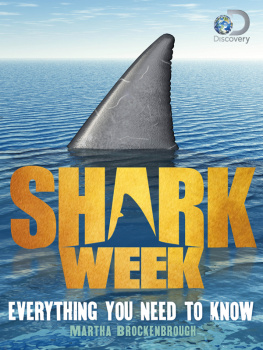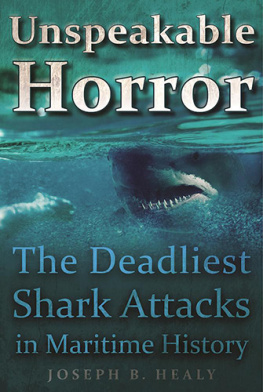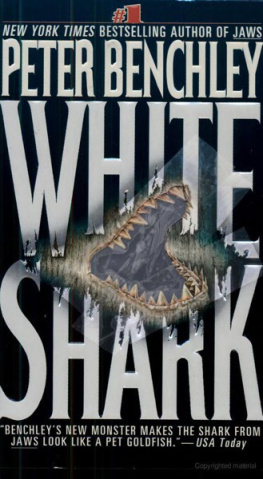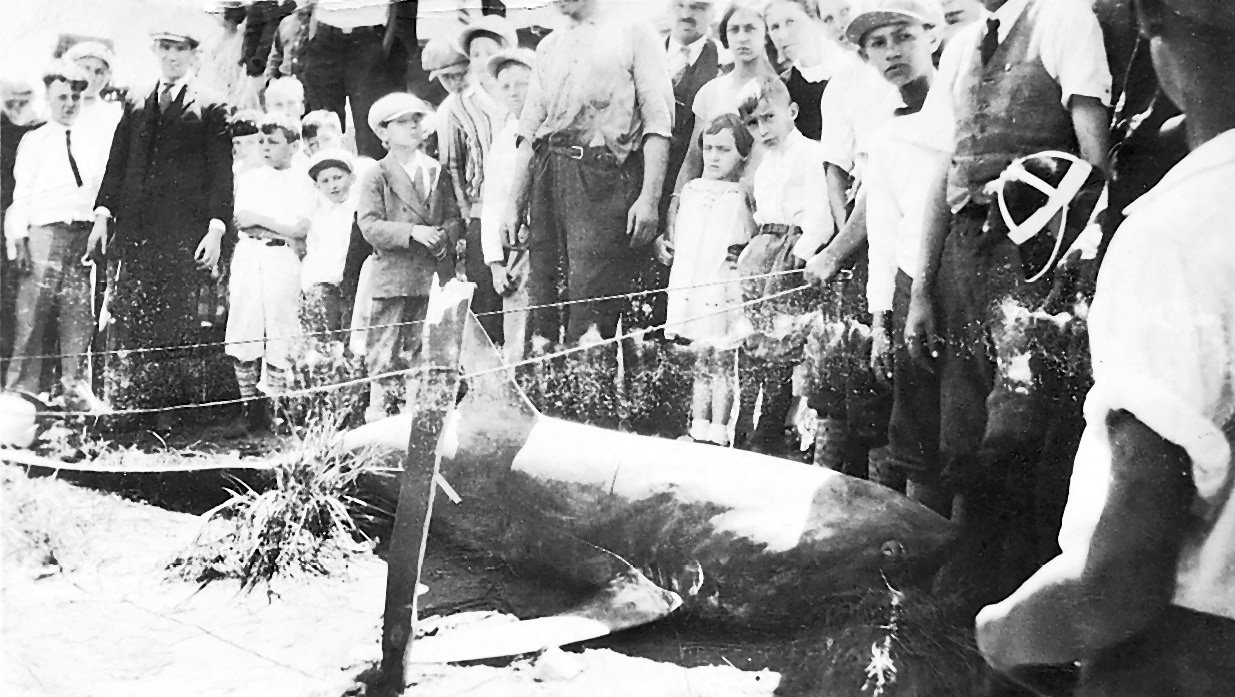Twelve Days of Terror
A thresher shark on display. One of the many 1916 man-eaters.
Twelve Days of Terror
Inside the Shocking 1916 New Jersey Shark Attacks
Richard G. Fernicola, M.D.


An imprint of Rowman & Littlefield
Distributed by NATIONAL BOOK NETWORK
Copyright 2016 by Richard G. Fernicola
All rights reserved . No part of this book may be reproduced in any form or by any electronic or mechanical means, including information storage and retrieval systems, without written permission from the publisher, except by a reviewer who may quote passages in a review.
photo credits
Frontispiece: Courtesy Wayne T. Bell
page xviii: Courtesy George H. Moss, Jr. Archives
page 2: Courtesy John Bailey Lloyd
page 63: Courtesy Clark C. Wolverton
page 128: Courtesy Department Library Services, American Museum of Natural History
page 163: Courtesy Department Library Services, American Museum of Natural History
page 251: Reprinted with permission from Distribution of the White Shark, Carcharodon Carcharias in the Western North Atlantic by John G. Casey and Harold L. Pratt, Jr., 1985
Illustrations on pages 182, 184, 185, 189, and 191 by Philip Shaheen III and Danielle Cather.
British Library Cataloguing in Publication Information Available
Library of Congress Cataloging-in-Publication Data available
ISBN 978-1-4930-2324-0
ISBN (e-book) 978-1-4930-2325-7
 The paper used in this publication meets the minimum requirements of American National Standard for Information SciencesPermanence of Paper for Printed Library Materials, ANSI/NISO Z39.48-1992.
The paper used in this publication meets the minimum requirements of American National Standard for Information SciencesPermanence of Paper for Printed Library Materials, ANSI/NISO Z39.48-1992.
To my mother
... and let them have dominion over the fish of the sea...
Genesis, 1:26
Contents
Acknowledgments
D uring the investigation of a dramatic, historic, and scientifically compelling event, a great number of sources must contribute to the comprehensive success of the project. The creation of this book, therefore, represents a tribute to the long list of generous people and organizations that provided essential pieces to a very complex puzzle.
The thanks I am obligated to bestow likely begins with an anonymous figure I met on a New Jersey-bound train from Washington, D.C., in the early 1980s. I was on my way home for a weekend away from college when a man sitting next to me learned that I was interested in marine biology. The man bought me a beer and described the attacks of 1916. It was the first time Id heard them in such detail. From there, I consulted with friend, neighbor, and New Jersey waterman Dr. Dennis Sternberg, and the reality of the 1916 attacks began to snowball. The library and microfilm then became my home and works like Shadows in the Sea and Richard Ellis Book of Sharks told me that others knew of the New Jersey attacks as well.
The recollections of witnesses who welcomed me into their homes will never be forgotten or underappreciated, and it is from their memories that I derived the driving force and inspiration that made every step of the study a work of intrigue. Posthumous thanks must go to the witnesses George Red Burlew, Bill Burlew, Johnson Cartan, Mildred Fisher, John Applegate, Russell Cable, Leroy Smith, Dr. Robert Patterson, and Alva Allen. Thanks must also go to the following witnesses and the relatives of primary witnesses such as Mary Bailey, Jackie Ott, Marion Smith, Annette Baker, Jerry Hourihan, Sarah Ellison, June Rounds, the Vineyard family, and Gwen Reddy. Doris Enterline of Matawan was an absolute angel in her assistance to find many of these sources.
The scientific research and formal assistance of countless individuals also became essential to assembling a coherent and powerful approach to the elusive mystery. Richard Ellis, George Burgess, Peter Klimley, Stewart Springer, John McCosker, Jack Casey, Harold Pratt, Ralph Collier, Marie Levine, Mark Marks, Dean Fessler, Erich Ritter, and many other premier shark researchers are responsible for shedding light on the debate encapsulated in this volume.
The private collections, photographs, unique research material, and vital contacts that the following men, woman, and organizations provided makes this presentation a complete picture of the period and personalities studied. They are Clark C. Wolverton, Malcolm Barhenburg, Walter Jones, George Moss, James Foley, Patricia Colrick, James Stone, Jim OShea, Tim McMahon, Maurice Cuocci, Wayne T. Bell, Robert Stewart, Dick Labonte, Zoe Wells, Helen Henderson, John Bailey Lloyd, The National Archives, The American Museum of Natural History, The Brooklyn Museum, The University of Pennsylvania Alumni Office, The Smithsonian Institution, The Florida Museum of Natural History, The Ocean County Historical Society, The Spring Lake Historical Society, The Matawan Historical Society, the Matawan Public Library, The Rutgers University Alexander Memorial Library, The Asbury Park Public Library, Monmouth University Guggenheim Memorial Library, and the Neptune Museum.
Personal thanks must also go to Gregory Fernicola, Robert Fernicola, Ronald Fernicola, my cousin, Paul Fernicola, and Joseph Hornick. Philip Shaheen III, Danielle Cather, and Lorraine Shaheen, were indispensible toward the completion of the artwork. I can never forget the innumerable occasions of help and patience provided by Vera Fernicola.
It may not be widely known, but New Jersey is home to some very prominent names in the world of sharks. Marie Levine of Princeton is the director of the Shark Attack Research Institute and specializes in South African attacks. David Doubilet of Elberon is a world-renowned shark photographer whose photos have graced the front pages of National Geographic and other noted magazines. Accomplished underwater photographer Stan Waterman also resides in New Jersey, I believe. Peter Benchley, too, is a resident of Princeton, New Jersey. Perhaps it is only fitting that the great effort put forward in this work is an examination of a New Jerseybased story. The subject matter just happens to have worldwide implications.
Preface
S ummer 2016 marks the 100th anniversary of the epochal New Jersey shark attacks. Undoubtedly, this milestone will generate new reflection on a century-old cold case.
The 1916 events were stunning in their ferocity, timeline, and location. The stories surrounding them are filled with tragedy and heroism and the scientific, geopolitical, and cultural contexts of the day are fascinating.
Regardless of the bizarre and confounding nature of these attacks, it is mans general impression of the shark that drives most interest. The shark, with its prominent teeth, large size, sandpaper-like armor, vitality, relative insensibility, and stealthy approach causes fear. On rare occasions, a shark will dismember its victim alive. As a chief attack investigator said in 1916, There is something peculiarly sinister in the sharks make-up... suggesting an evil spirit. Unlike large terrestrial predators, it rarely administers a coup de grce to the neck during an assault. In a world where man is the most precious resident and its most powerful predator, a shark attack is perceived as a violation of the natural order.
Next page














 The paper used in this publication meets the minimum requirements of American National Standard for Information SciencesPermanence of Paper for Printed Library Materials, ANSI/NISO Z39.48-1992.
The paper used in this publication meets the minimum requirements of American National Standard for Information SciencesPermanence of Paper for Printed Library Materials, ANSI/NISO Z39.48-1992.